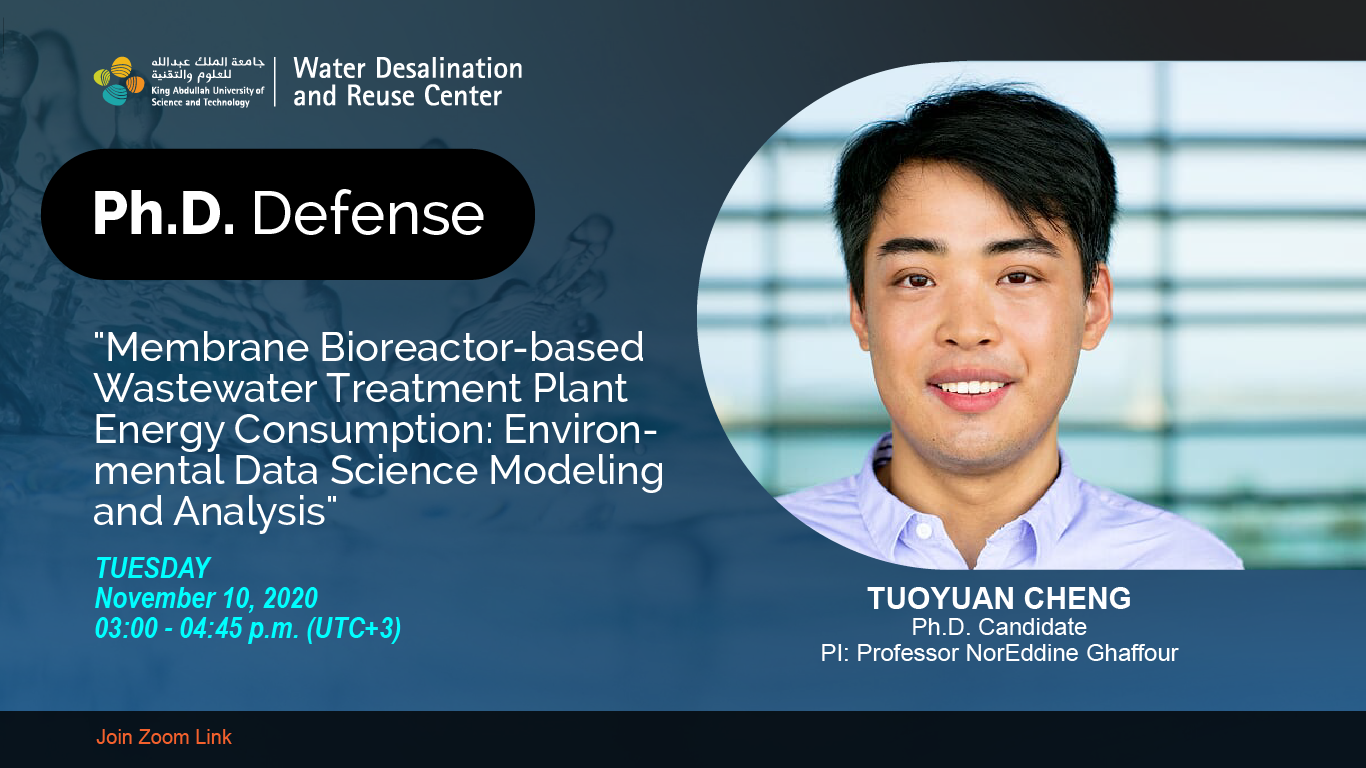
Ph.D. Defense: Tuoyuan Cheng
PI: Professor NorEddine Ghaffour
Tuesday, Nov 10, 2020 l 03:00 - 04:45 pm (UTC+3)
Join Zoom link:
Meeting ID:960 7723 1420 l Password:059785
Membrane Bioreactor-based Wastewater Treatment Plant Energy Consumption: Environmental Data Science Modeling and Analysis
Abstract:
Wastewater Treatment Plants (WWTPs) are sophisticated systems that have to sustain long-term qualified performance, regardless of temporally volatile volumes or compositions of the incoming wastewater. Membrane filtration in the Membrane Bioreactors (MBRs) reduces the WWTPs footprint and produces effluents of proper quality. The energy or electric power consumption of the WWTPs, mainly from aeration equipment and pumping, is directly linked to greenhouse gas emission and economic input. Indeed, biological treatment requires oxygen from aeration to perform aerobic decomposition of aquatic pollutants, while pumping as an indispensable role in WWTPs, consumes energy to overcome friction in the channels, piping systems, and membrane filtration.
In this thesis, we researched full-scale WWTPs Influent Conditions (ICs) monitoring and forecasting models to facilitate the energy consumption budgeting and raise early alarms when facing latent abnormal events. Accurate and efficient forecasts of electric power consumption and ICs could avoid unexpected system disruption, maintain steady product quality, support efficient down-stream processes, improve reliability and save energy. We carried out a numerical study of bioreactor microbial ecology for MBRs microbial communities to identify indicator species and typical working conditions that would assist in reactor status confirmation and support energy consumption budgeting. In order to quantify membrane fouling and cleaning effects at various scales, we proposed quantitative methods based on Matern covariances to analyze biofouling layer thickness and roughness obtained from Optical Coherence Tomography (OCT) images taken from a gravity-driven Membrane Bioreactor (MBR) under various working conditions. Such methods would support practitioners to design suitable data-driven process operation or replacement cycles and lead to quantified MBR monitoring and energy saving.
For future research, we would further investigate data from other full-scale wastewater treatment processes with higher sampling frequency and apply kernel machine learning techniques for effective process global monitoring. The forecasting models would
be incorporated into optimization scenarios to support data driven decision making. Samples from more MBRs would be considered to gather information on possible microbial community structures and corresponding oxygen-energy consumption in various working conditions. We would investigate the relationship between pressure drop and spatial roughness measures. Anisotropic Matern covariance related metrics would be adopted to quantify the directional effects under various operation and cleaning working conditions.
Short Bio:
Tuoyuan Cheng received his bachelor's degree in engineering from Harbin Institute of Technology in 2014. He is currently pursuing his Ph.D. degree in environmental science and engineering at King Abdullah University of Science and Technology. His current research includes applications of anomaly detection, data-driven prediction, and optimization in water/wastewater treatment plants and water distribution systems. Tuoyuan is also a chartered financial analyst (CFA) candidate and holds a certificate in quantitative finance (CQF).



